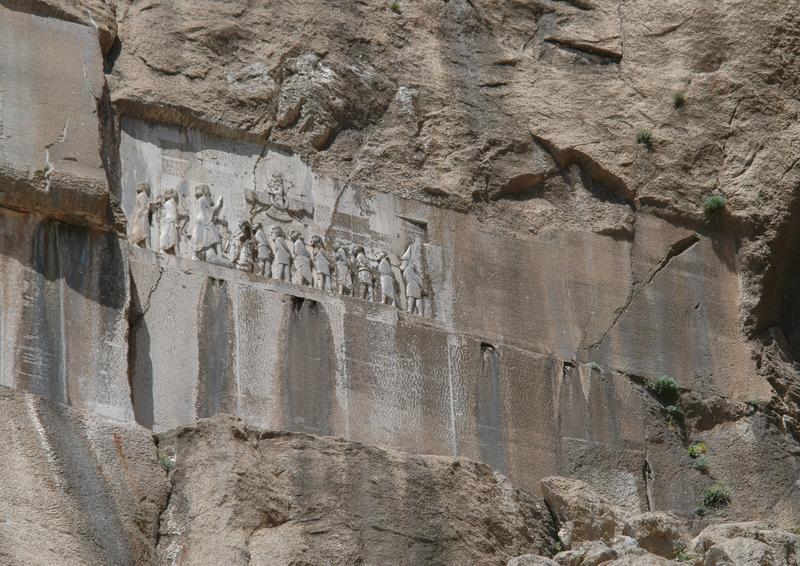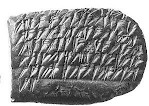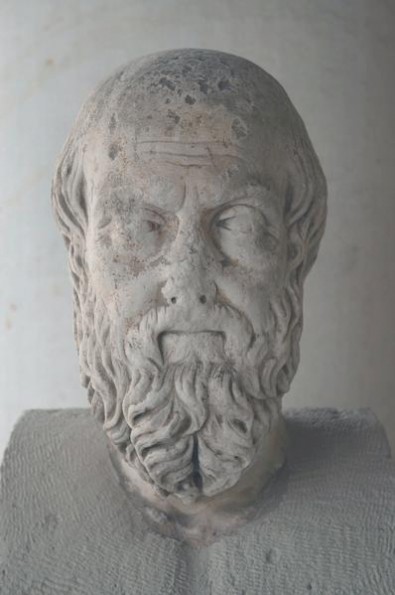Darius the Great: Sources
Darius I (Old Persian Dârayavauš): king of ancient Persia, whose reign lasted from 522 to 486. He seized power after killing king Gaumâta, fought a civil war (described in the Behistun inscription), and was finally able to refound the Achaemenid empire, which had been very loosely organized until then. Darius fought several foreign wars, which brought him to India and Thrace. When he died, the Persian empire had reached its largest extent. He was succeeded by his son Xerxes.

The reign of king Darius is very well documented. Far better, for example, than that of most of his successors.
Our greatest asset is the Behistun inscription, which is nothing less than Darius' autobiography. It is engraved on a cliff about 100 meters off the ground along the road between Ecbatana and Babylon, and consists of a relief and a text. The relief shows two Persian courtiers, Intaphrenes and Gobryas, and king Darius in a victorious pose, standing in front of a line of defeated enemies. From the sky, the supreme god Ahuramazda looks benevolently down upon Darius. In the inscription, Darius tells how he, by the grace of Ahuramazda, killed Gaumâta, became king, and defeated his enemies.
The text cannot be read by human beings because it is too high on the cliff. Darius was, therefore, speaking to the gods, and this makes it unlikely that he is not speaking the truth. Above, we entertained the possibility that Gaumâta was, as he claimed to be, really the brother of Cambyses, and that Darius did not kill a mere usurper, but a man with a better claim to the Persian throne. Taking into account the position of the inscription, we can almost certainly exclude this possibility. Gaumâta was a liar indeed. Which does not mean, however, that Darius was the first in line of succession. The question remains: why did Darius, who was not directly related to Cambyses or Cyrus, become king?

Other texts from Persia are the Persepolis fortification tablets. They were discovered in Darius' religious capital Persepolis and deal with the economic administration of the region in the years until 493 BCE. Darius' uncle Pharnaces was in charge with this part of the Persian government. Although these tablets, written in Elamite, are not exactly entertaining to read, their content is very interesting. Several transactions deal with the sacrifices to the gods, others with the rations for Darius' wives; we also find travel permits. So we can deduce information about the status and whereabouts of Darius' courtiers. Comparable texts are known from Babylonia, one of the most important satrapies of the Persian empire.
A related group of sources consists of the building inscriptions of the royal palaces at Susa, Persepolis, and several other places. Although they merely state that Darius erected this or that building, they also inform us about the origin of the products, which tells us a lot about the economic realities of the Achaemenid empire. We know that at Susa, timber was used from mountains of the Lebanon and the valley of the Indus.
A source of a completely different nature is the entertaining book of Histories by Herodotus of Halicarnassus (c.480-c.429). This important and accessible work offers a history, geography and ethnography of the eastern Mediterranean world. A book so diverse could easily have become chaotic, and therefore, the Greek researcher organized it around the theme of the Persian expansion from Cyrus to Xerxes. The result is essentially a history of Persian imperialism, which is frequently interrupted to describe the peoples conquered by Cyrus, Cambyses, Darius, and Xerxes.

In the first book of this treasure, Herodotus tells about the wars of Cyrus against the Lydian king Croesus, against Nabonidus' Babylon, and against the nomads of Central Asia. The second book is one large digression on Egypt, and is followed by the stories of Cambyses' conquest of Egypt and the double coup d'état of Smerdis/Bardiya/Gaumâta and Darius. In Book 4, Herodotus tells about Darius' campaign against the Scythians; it is followed by the story of the revolt of the Ionian Greeks, which results in a Persian punitive action against Greece, culminating in the battle of Marathon. The last three books describe Xerxes' ill-fated campaign against Greece.
Herodotus offers a vivid story -he is easily the most accesible author of the ancient world- but the reliability of the Histories is much debated (already in Antiquity). For instance, it can be proven that he never visited Babylon, even though he claims to have spoken to Babylonians and uses highly suggestive but misleading phrases like "this was still visible in my time". Yet, he is the only one who offers a continuous account of the expansion of the Persian empire, and as a rule of the thumb, we must accept his stories, unless we have very good reasons to believe the opposite.
This sounds plausible, but during the last decades, many scholars have tended to do the opposite. This was refreshing. It was certainly important to start with the Egyptian and Babylonian sources and establishing Herodotus' reliability only at a later stage. However, scholars sometimes seem to have become a bit too skeptical. The point is that Herodotus is neither a modern scholar nor a liar. He was, essentially, an entertainer.
There are other sources, but usually they are usually too late to add something of importance. The only one who needs to be mentioned is the Greek author Ctesias of Cnidus, who served as one of the doctors of king Artaxerxes II Mnemon (404-358). He claims to have written his History of the Persians to correct the errors of Herodotus, but it looks as if he is even more unreliable. Although he sometimes offers plausible information, it is far better to accept Herodotus. For example, when we discuss Darius' youth.